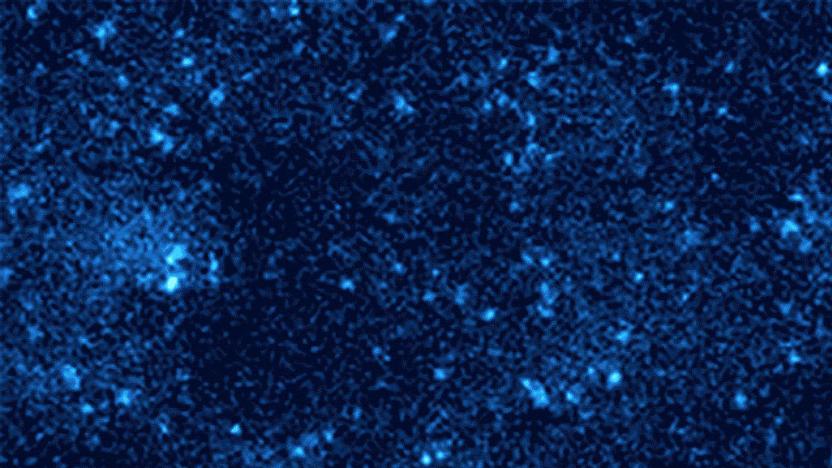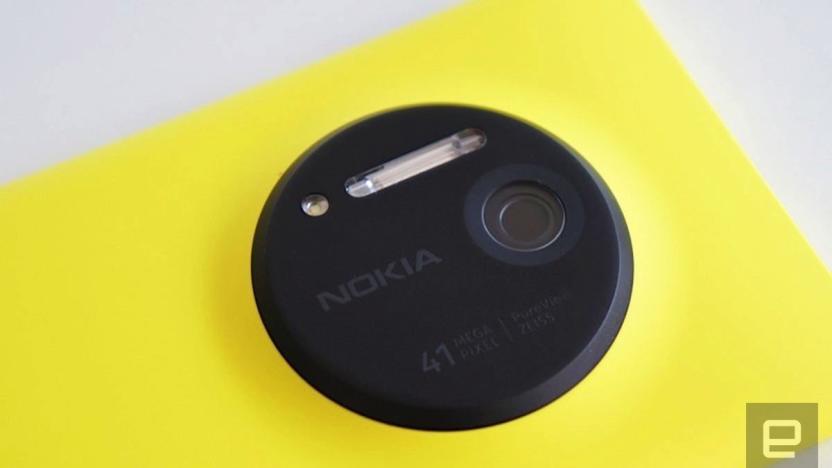DnaSequencing
Latest

Tiny light-up barcodes help researchers identify DNA molecules
How do you identify one molecule among tens of thousands? Traditionally, scientists dye molecules in various colors. But what if each individual molecule had its own unique identifier? Researchers at Duke University are trying to make that a reality by labeling molecules with short strands of light-up DNA. The team discussed their invention, which they deem "temporal barcodes", in a paper published this month in the journal ACS Synthetic Biology.

Low-cost DNA sequencer uses Nokia 1020's camera as a microscope
If the Nokia 1020 has a memorable feature, it's surely the phone's 41-megapixel camera -- the same one a team of researchers are now using for their phone-based DNA sequencer and molecular analyzer. The scientists from the University of California, Los Angeles, Sweden's Stockholm University and Uppsala University have developed a $500 3D-printed phone attachment that turns a device's camera into a microscope. Health workers in developing nations and remote locations can use the attachment to find genetic mutations that cause diseases without having to send samples to a lab. It's definitely a lot more affordable than comparable microscopes medical professionals use, which could cost tens of thousands of dollars.

NASA uses a DNA sequencer in space for the first time
The crew of the ISS just took the first step towards making the orbital laboratory a little safer for its inhabitants. For the first time ever, NASA astronauts have sequenced DNA in microgravity. The experiment was actually a test to see if a MiniION portable DNA sequencer would work in orbit -- so far it does. The samples tested on the ISS produced the same results as a control group back on earth. If further tests pan out, astronauts will be able to use the sequencer to test microbes found on ISS surfaces.

NASA brings a DNA sequencer to space for the first time
SpaceX's after-midnight Falcon 9 launch didn't just advance the state of the art in rocket landings... the cargo it launched is groundbreaking, too. NASA notes that the mission is the first to bring a DNA sequencer to space. The Biomolecule Sequencer will not only demonstrate that you can sequence genes in microgravity, but provide a valuable service to the International Space Station's crew. They can use it to check up on crew health, identify microbes and maybe (just maybe) detect life beyond Earth. It's dramatically more convenient than before, when astronauts had to wait months to send DNA samples back to Earth.

New algorithm performs complex DNA origami
Researchers from MIT, Arizona State University and Baylor University have developed a new algorithm that promises to simplify the arduous and complex task of assembling DNA into structures other than a double helix. These structures could eventually be used as everything from DNA storage modules to delivery vehicles for CRISPR enzymes and other medicines, but until now the process of creating them has been prohibitive.

MinION USB-sized DNA sequencer goes through real-world testing
Back in 2012, a UK company called Oxford Nanopore announced a chewing gum packet-sized DNA sequencer, something that people found hard to believe since rival machines can be as big as fridges. After dealing with technical issues and bugs (as well as being accused of launching vaporware), Oxford has finally begun making that device called MinION available to beta testers. Several of the testers (mainly scientists doing research in educational institutions) reported that it only exhibits a 60 to 85 percent accuracy. While that's nowhere near more traditional sequencers' 99.99 percent accuracy, many of the testers still believe that the device could be a game changer due to its size and relatively affordable price. Traditional sequencers could cost as much as $1 million, while the testers bought their MinIONs for only $1,000 each.

One Codex wants to make searching DNA as easy as using Google
Once upon a time, sequencing your genome was a prohibitively expensive proposition -- mapping out your genetic code cost hundreds of thousands of dollars and the practical applications of the data were few and far between. These day the process is so affordable that health care professionals are sitting on petabytes of genome data. Making use of that data, however, is another problem. The current genome searching algorithm, called BLAST, isn't particularly fast. A new firm hopes to change that, and is introducing One Codex: a genetic search platform that can index DNA base pairs 1,500 faster than contemporary databases.

Hand-held malaria tester sequences DNA, suggests meds quickly
Despite how far we've come with technology, malaria is still a serious threat for huge chunks of the developing world. A prototype tool from UK-outfit QuantuMDx, however, could help stave off mosquito-related deaths by giving health-workers the power to diagnose the disease in 10 - 15 minutes. As the team tells it, typical DNA sequencing can take days, weeks or even months, but its "lab on a chip" can rapidly diagnose a disease and accurately predict which drug and what dosage to administer -- all based on the parasite's genetic code. That last bit is key because malaria has a nasty habit of being resistant to medications.

Max Planck Institute sequences genome of Siberian girl from 80,000 years ago, smashes DNA barriers
We've known little of the genetic sequences of our precursors, despite having found many examples of their remains: the requirement for two strands in traditional DNA sequencing isn't much help when we're usually thankful to get just one. The Max Planck Institute has devised a new, single-strand technique that may very well fill in the complete picture. Binding specific molecules to a strand, so enzymes can copy the sequence, has let researchers make at least one pass over 99.9 percent of the genome of a Siberian girl from roughly 80,000 years ago -- giving science the most complete genetic picture of any human ancestor to date, all from the one bone you see above. The gene map tells us that the brown-skinned, brown-eyed, brown-haired girl was part of a splinter population known as the Denisovans that sat in between Neanderthals and ourselves, having forked the family tree hundreds of thousands of years before today. It also shows that there's a small trace of Denisovans and their Neanderthal roots in modern East Asia, which we would never have known just by staring at fossils. Future discoveries could take years to leave an impact, but MPI may have just opened the floodgates of knowledge for our collective history.

MinION USB stick decodes DNA in a matter of seconds
If you happen to be "special," then this $900 USB device is just about the worst thing ever. The aptly named MINion serves its masters by interrogating the cells of living organisms and rooting out their genetic secrets. We won't pretend to know exactly how it works, but it starts by pulling a strand of DNA through a razor-like nanotube that unzips the double helix. The nucleotide bases are then electrocuted one by one until they give up their code. The resulting sequence is stored like a ticker-tape readout, for the whole world to see. The MinION can complete its task in seconds and, unlike most other DNA sequencers, it's portable and simply plugs into a laptop. Luckily, it has so far only been shown to work on very short genomes, like those belonging viruses and bacteria, so for now you're probably safe.

Nanopore DNA sequencing technique promises entire genome in minutes or your money back
Those vaguely affordable DNA tests that promise to tell you just how likely you are to be stricken by some horrible and unavoidable genetic affliction in the future? They only look at a tiny fraction of the bits and bobs and bases that make up your genetic code. There's a race on to develop a quick and inexpensive way to sequence a human's entire genome, a process that costs about a million thousands of dollars now and takes ages but, via the technique under development at Imperial College London, could be done in a few minutes for a couple of bucks in 10 years. The process relies on nanopores, which are the go-to tech for companies trying to pull this off. Basically, a DNA strand is pushed through a 2nm hole on a silicon chip and, as it moves through, that chip is able to use an electrical charge to read the strand's coding sequence. That is then spit out to a supercomputer to crunch the numbers at a speed of 10 million bases per second and, within minutes, you too can have some hard data to make you freak out about the future -- and maybe a place to put your iPod, too. Update: As many of you pointed out, there are multiple places to get your full genome scanned now for prices in the mere thousands of dollars. Pocket change, really.

Ion Personal Genome Machine: the DNA sequencer with an iPod dock
We're still struggling to find the speakers on this thing, but Life Technologies' new Ion Personal Genome Machine does at least have one big advantage over most other iPod docks: it's... a personal genome machine. Curiously, the company itself isn't doesn't seem to be talking up the iPod dock at all, but MedGadget reports that it can be used to explore a genome and check on the status of given sequencing run with either an iPhone or iPod touch. As for the device itself, while it's still only designed for research use and "not intended for animal or human therapeutic or diagnostic use," the company does have some pretty grand designs for the future. According to Ion Torrent founder Dr. Jonathan M. Rothberg, the company hopes to eventually do nothing short of doing for DNA sequencing what digital cameras did for photography. Head on past the break for the complete press release.







